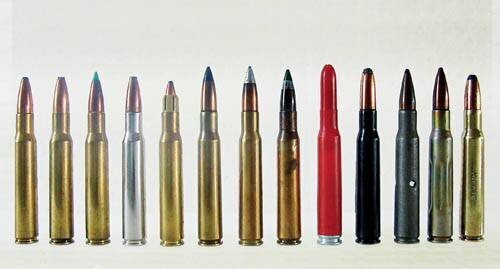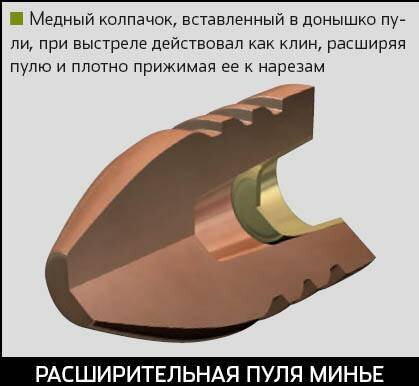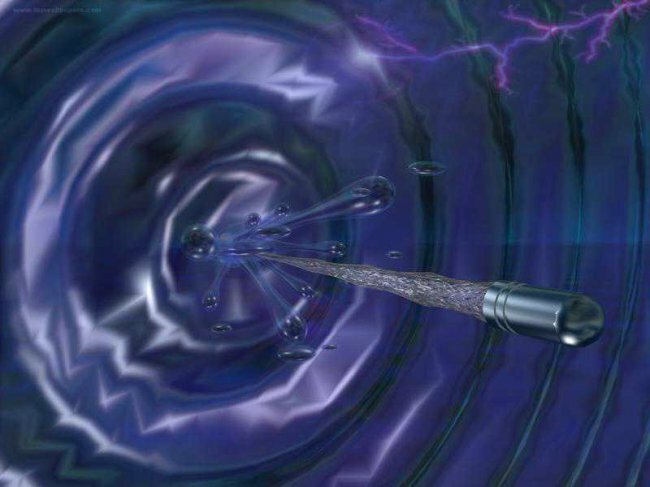The Last Kings Argument: How the fool is arranged
In the 17th century, Cardinal Richelieu ordered that the inscription Ultima ratio regum (“The Last Kings Argument”) be minted on all cannons cast in France. A century later, the Prussian king Frederick II decided to follow his example: the inscription on the Prussian guns read: Ultima ratio regis (“The Last Argument of the King”).

But the simple infantryman always put an end to the conflicts of the warring parties. It was he who broke into the last enemy stronghold and guided his gun at the enemy king. Looking at the trunk, where a small lump of lead was hidden, the loser put his signature in the act of surrender. This little ball is called a bullet.
Bullet modern small weapons comes from balls that the ancient warriors were throwing from a simple, but very effective device - sling. As you know, a puny and stunted David defeated a huge and powerful Goliath with the help of a stone thrown from a sling.
When gunpowder was invented and the first cannons appeared, their cores were made of stone, later - of cast iron. The first guns were initially charged with round lead bullets. They were made simply - they made a groove in the ground, into which molten lead was poured. The lead bar was cut into pieces and shaped into a ball, rolling between two cast-iron plates. The caliber of guns in those days was determined not by millimeters or fractions of an inch, as today, but by the number of bullets that can be cast from one pound of lead (454 g). This tradition has been preserved in hunting rifles - “16 caliber” means that one pound of lead will make 16 bullets.

Up to the second third of the 19th century, the world practically did not know any other bullet, although in the 15th century it didn’t satisfy the shooters much. Many attempts have been made to come up with something more perfect. The bullet was the main obstacle in increasing the rate of fire and the range of rifles, their accuracy: the lead ball at a distance of 300 m gave a deviation to 2 m.
To increase accuracy, rifles with rifled barrels appeared in 1615, which made the bullet rotate, which ensured a significant increase in accuracy and firing range. However, for such a gun it was necessary to make bullets of a smaller diameter than the diameter of the barrel bore, and lowering it into the barrel, expanding it with a hammer blow on the ramrod. In this case, the bullet was deformed, which affected the accuracy of shooting and flight range.
Of course, the design thought did not stand still, but these inventions didn’t give significant advantages compared to a simple spherical bullet. Winning one led to even greater losses in the other.



Not a ball
In 1848, French captain Minier finds a truly brilliant way out. What if the bullet is expanded — and not spherical, but oblong — powder gases themselves? In the bottom of the bullet, he inserted a copper cap, when fired, a blow of powder gases drove it into soft lead like a wedge. The bullet expanded and tightly pressed against the rifle. Migner's rifle was charged as easily as a smooth-bore gun, but it was three times as powerful as a battlefield.
But the pool of Mignet was prepared for a short life. Pretty soon gunsmiths began to use a unitary cartridge invented at the beginning of the 19th century - a metal case for charging gunpowder into which a bullet was inserted from above. It became possible to charge the rifle not from the barrel, but from the breech. Began to use the bolt, unlocking and locking the barrel. The sleeve, expanding when fired, pressed tightly against the walls of the channel and prevented gas from breaking back.
Now it turned out to be enough to make the breech of the barrel, where the cartridge is placed, slightly larger in diameter, and move the rifling a little further. When fired, a bullet, starting a movement in the barrel, crashes into the grooves.
So the familiar cartridge with an extended bullet appeared to all of us. By the way, if you measure the diameter of an 7.62 mm bullet with an accurate instrument, you may be surprised to find that it is not 7.62 mm, but 7.92 mm. In fact, the caliber is not determined by the diameter of the bullet, but by the diameter of the bore along the ribs of the rifling ribs: this is 7.62 mm 0,3 mm differences ensure rotation of the bullet through the cuts. Therefore, the claims that the Soviet three-pitch caliber was 7.62 mm, and the German 7.92 mm, may look strange, but are explained by the differences in the definition of the caliber. In some countries, it is defined as the distance between the rifling fields (the smallest diameter of the bore), in others, the distance between the rifling bottoms (the largest diameter).
If for a round bullet rotation in flight is desirable, then for an oblong one is obligatory. Such a bullet, being fired from a smooth-bore gun, immediately begins to tumble and prowl. It’s even harder to hit the target than a round one. Therefore, oblong bullets in army smooth-bore guns have not been applied, although such attempts have been made repeatedly. The reason for the yawing and tumbling of a bullet is that the center of application of aerodynamic forces (center of pressure) and center of gravity do not coincide (usually for technological reasons). Couples of forces arise, which overturn a bullet, force it to scour. The rotation of the bullet makes it a kind of gyroscope, and, like any gyroscope, it maintains its position in space unchanged - a nose forward.
The smaller the eccentricity (the distance between the centers of gravity and pressure) of the bullet, the more accurately it hits the target (experts say: “accuracy is higher”). And this is the main concern of those who develop cartridges. The most successful in design cartridges remain in service for many decades, moving from one weapon to another. For example, the bullet of the famous Mauser pistol caliber 7.63 mm, which appeared at the end of the XIX century, was later used in the Soviet TT pistol, PPD, PPSH, PPS and a number of other pistols. Yes, and its popularity in the world TT pistol owes a lot to the successful selection of the cartridge.
Bullet expansion
At the end of the 19th century, a revolution was outlined in combat small arms: the transition from black smoke powder to smokeless. The caliber of the weapon decreased (6,5 – 8 mm instead of 10 – 12 mm). To improve the ballistic characteristics of bullets fired from such weapons, they began to cover them with a metal sheath. However, it turned out that the new small-caliber shell bullets had a too weak stopping effect, punching the enemy through and leaving neat entrance and exit holes. The way to solve this problem in the middle of the 1890-x is attributed to the captain Clay from the British arsenal of Dum-Dum near Calcutta, who was engaged in the development of .303 caliber bullets for the Lee-Metford rifle. Contrary to popular belief, Clay did not begin to make cruciform rifling (they appeared later as a cheap way of making expansive bullets in the field), but suggested simply cutting the nose of a bullet, as a result of which it became semi-shell. Once in the body, such a bullet was deformed, "opening up" and giving all its energy. At the same time, the punching effect of the bullet decreased, and the stopping effect increased. The name of the arsenal has taken root and has become a household name for expansive ("drop-down") bullets.
When hit in soft tissue, an expansive bullet inflicted severe wounds. For this reason, already several years later, at the First Hague Peace Conference in 1899, bullets that opened up and deformed in the human body were banned for military use. IV The Hague Convention in 1907 confirmed the ban, but during subsequent wars many countries repeatedly “forgot” about it.
Expansive bullets are widely used now - not in military conflicts (this is still prohibited), but as a hunting ammunition. In addition, expansive bullets are widely used in police weapons: a high stopping effect is combined with a low probability of “bleeding” when hit the target (this reduces the risk of casual passers-by).
The tompak or melchior envelope has another role - it provides the constant geometric shape of the bullet when carrying cartridges in pouches, as well as at the time of loading, which has become especially important for multiply charged rifles. In addition, the contamination of the rifling channel of the barrel with lead and the disruption of a bullet from the rifling were excluded. And the penetrating ability of a bullet in a hard shell turned out to be higher than a simple lead one. The same Hague Convention, based on the principles of humanism, has banned the use of bullets on the front, not having a hard shell. This ban (a rare case) has been strictly implemented by all countries for a hundred years. True, the reason is not that everyone is imbued with the principles of humanism, but the fact that the shell bullet performs its main purpose better — to kill.
Armor and fire
With the appearance on the battlefields of the First World War, armored vehicles required bullets capable of piercing armor. The strength of the tompak or melchior shell was not enough. Then a steel core was inserted inside the bullet. Lead in the pool gradually began to turn from the base material into a weighting means. The heavier the bullet, the more kinetic energy it has. When meeting with the armor, the shell collapses, and the solid steel core breaks through it (the lead at the head of the bullet somewhat prevents the core from sliding to the side when the bullet meets the armor not at a right angle). The cores differ in size, degree of sharpness and shape - from simple cylinders to complex spindles. In addition to steel, more solid materials were also used (for example, the Germans used a tungsten carbide core).
An armor piercing bullet pierced the armor, but its action was limited by that. We also needed bullets that could set fire to highly flammable materials. So incendiary and armor piercing incendiary bullets appeared. The first ones contained in the head part an incendiary composition, usually white phosphorus, and acted well on targets that were not protected by armor - wooden houses, thatched roofs, haystacks. When a bullet hit her shell collapsed, and incendiary composition ignited from contact with air and set fire to the target. When a bullet hit a person, it opened up like a flower, similarly expansive, and even poisonous phosphorus got into the wound. But the First World War was already underway, and the Italian General Douay's apt remark: "... all restrictions, all international agreements that can be established in peacetime, will be swept away like dry leaves by the wind of war" turned out to be prophetic. Armor-piercing incendiary bullets were arranged similarly to an armor-piercing, but they also had an incendiary composition either at the head or at the bottom. Such bullets were intended primarily for firing at the fuel tanks of cars.
Fire arrows
With the advent of machine guns, the shooting of which was required to constantly adjust, we needed bullets, the trajectory of which would have been visible - tracer. In the shell, in addition to lead, an open container with a pyrotechnic composition is placed behind it. When fired, the composition is ignited with powder gases and burns with a bright fire of red, green, yellow or blue. It is lit for only 2 – 3 seconds, but at a speed of 900 m / s it is about 2 km. The glowing trail of such a bullet is clearly visible even in the daytime, but not the shooter himself (he looks after her exactly), but the commander or assistant located on the side.
The second purpose of tracer bullets is target designation. The squad leader always has one shop equipped only with tracer cartridges. Several long bursts of tracer bullets at a single target — and all the squad arrows carry fire at that target.
There are quite exotic bullets, such as sighting. When such a bullet hits a surface, it explodes, throwing a white cloud of smoke that is clearly visible from afar. It accurately indicates where the bullet hit (tracer bullet well shows the direction of flight, but not the point of impact). The sighting bullet has inside the simplest fuse in the form of an inertial projectile, a capsule with some explosives and a small amount of smoke-generating pyrotechnic composition. These bullets have no military significance, since the explosive charge is very small and small fragments of the shell cannot cause serious injuries. As a rule, such bullets are used in training artillery officers at miniature training grounds, where training mock-ups are installed at short distances. tanks, cars, buildings. Rupture of such a bullet simulates a rupture of an artillery shell, and officers learn to determine the range, deviation of the rupture from the target and make corrections.
Pistol bullets
As a rule, pistol bullets are either just shell / half-shell or have a steel core inside to increase penetration. Sometimes you can find pistol tracer bullets and even completely exotic - armor-piercing incendiary. But they are intended for firing from submachine guns at a distance greater than the usual firing range of pistols or revolvers.
The essential difference between pistol bullets and rifle bullets is their shape. From a rifle or automatic bullet requires a long range, and therefore good aerodynamics. The sharpness of the bullet provides her with a significant penetrating ability at long distances. From the pistol bullet, however, it requires a high stopping power and quick disabling of the enemy (at least for a few seconds). And if in the long-range small arms over the past 150 years we observe a steady tendency to reduce calibers (the Peabody – Martini rifle sample 1869 of the year - 11.43 mm, AK-74 assault rifle of the 1974 model of the year - only 5.45 mm), caliber pistols and revolvers practically do not change. Many researchers consider the minimum appropriate caliber 9 mm. The widespread caliber 7.62 mm, in their opinion, is insufficient due to the poor stopping power of the bullet.

Information